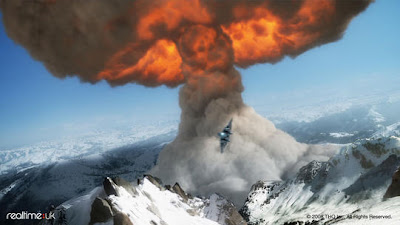Phil Shoebottom represented RealtimeUK North with a lengthily and extremely informative talk outlining his path into the industry and the production processes and pipeline used within the studio. Phil came from a Fine Art background and gained a BA in Creative Visualisation. He graduated from Teesside in 2003 and gained employment in technical Visualisation with a basis in engineering projects he moved onto games and had his first break on the game Big Mother Truckers. He by 2005 was with RealtimeUK as a junior Artist and through considerable amounts of hard work and earning respect amongst his peers has risen to senior lead artist. The Studio itself was founded in 1996 and is a CG production house with a small crew but many responsibilities. There are 25 full-time employees at the studio with freelancers hired in on larger projects. When watching certain examples of their work its hard to believe such a small studio is behind the visuals.
The team pipelines that the studio have in place allow specialism but it does help to be a generalist and not to rely on the entirety of the team for a project to go ahead. From project to project the pipeline alters and even small projects require one, here is an example pipeline i managed to quickly jot down in my notes:
- Script/ Act List
- Concept Art/Storyboarding
- Animatic
- Speed Paintings
- Scene Blockout
- Matte plane Holders + Asset Creation
- Asset Creation requires Rigging, Animation, Cache
- Scene Build (compiled of both Mattes + Assets)
- Scene Finishing + Effects
- Final Render
- Compositing + Effects
- Final Edit + Sound
Hope this pipeline example helps people to understand the workflow and order within RealtimeUK. An interesting point is that there are no specialised riggers in-house so this requires generalist staff to understand the technicalities of rigging. Here is the way in which the studio handle a brief:
- A session with the team and youtube references to find influences.
- Idea generating sessions (brainstorming/mindmaps)
- Concept Work
- Concept Key Frames
The studio has over a decades experience in the industry and has learnt how best to handle and predict the outcome of projects. their lesson is that once you know the deadline to work backwards. Scheduling comes with experience and making an educated guess at potential complications in a projects allows foresight to tackle the obstacles head on. The key to achieving a deadline is to predict the pitfalls and overlook the aspects that can be overlooked.
The studio have traditionally blocked out with library models allowing a professional but quick visualisation to send to clients. This procedure can sometimes cut out the need for storyboard all together, saving time and money. These examples of cutting corners and remaining presentable influence the development of my own projects.
The asset creation takes on the whole around 12 weeks. A design will be supplied in many cases by the client and then once concept art has been approved the two will act as the direction of the asset. Modeling can be inspired by airfix kits in the case of their more vehicle orientated work, for their scale and precise realistic details. Textures and early shaders are then applied and demo renders are sent of approval by the client.
At this point I am around half way through my notes from the RealtimeUK talk so part 2 will be on its way soon. Hope this is helpful to people, I feel that this information and advice is a very realistic portrayal of the exciting and high octane pipeline that the industry expects from studios.



No comments:
Post a Comment